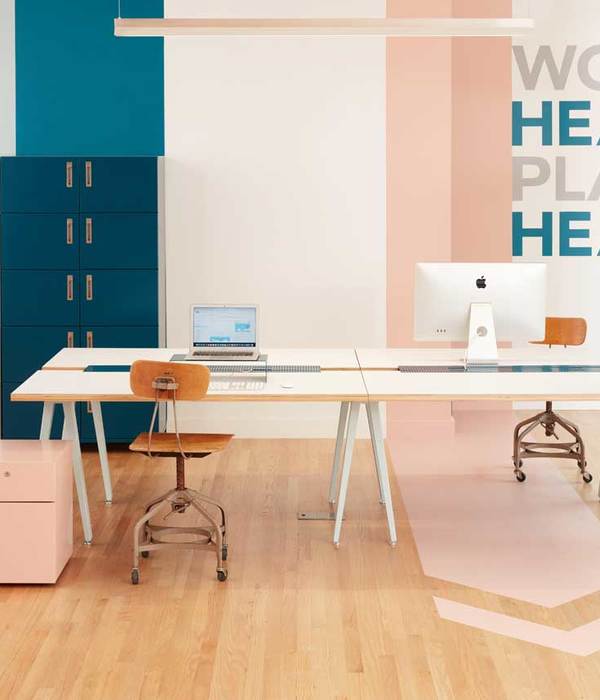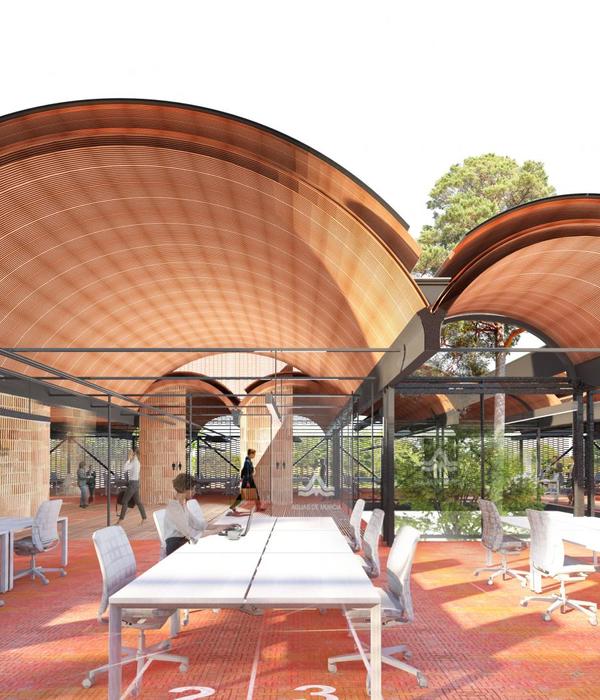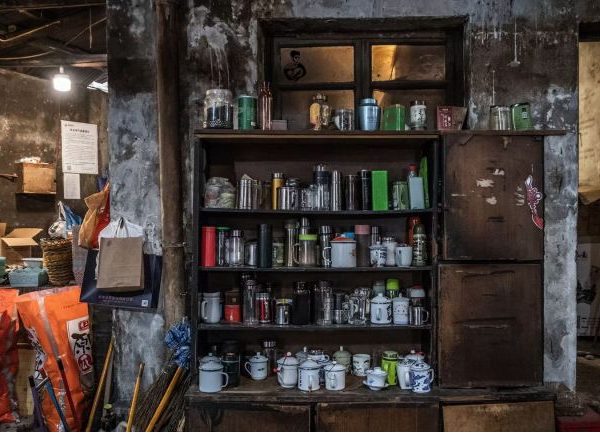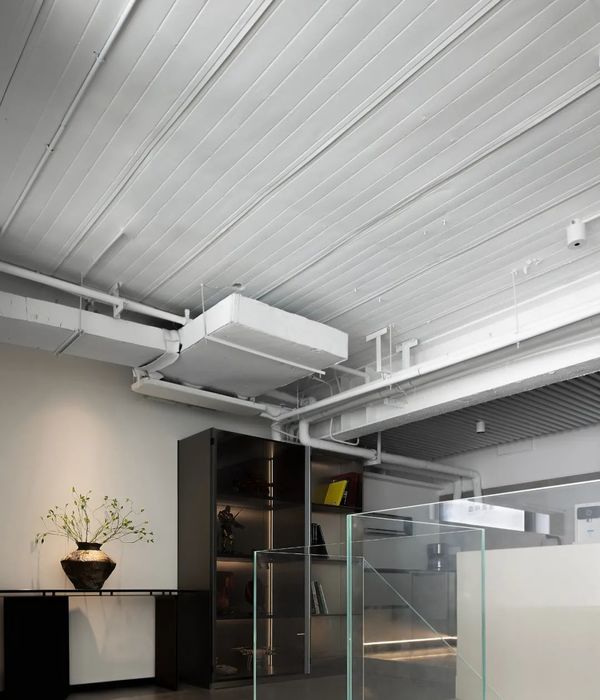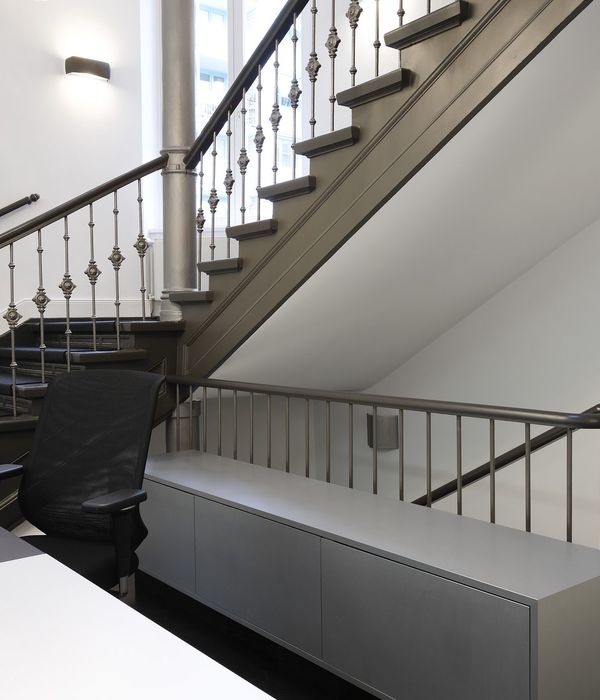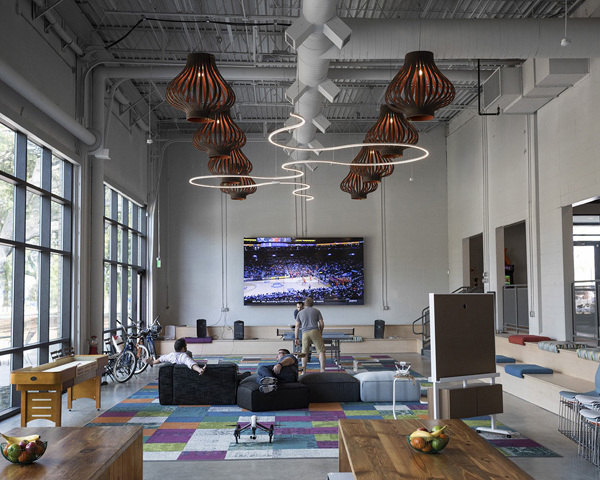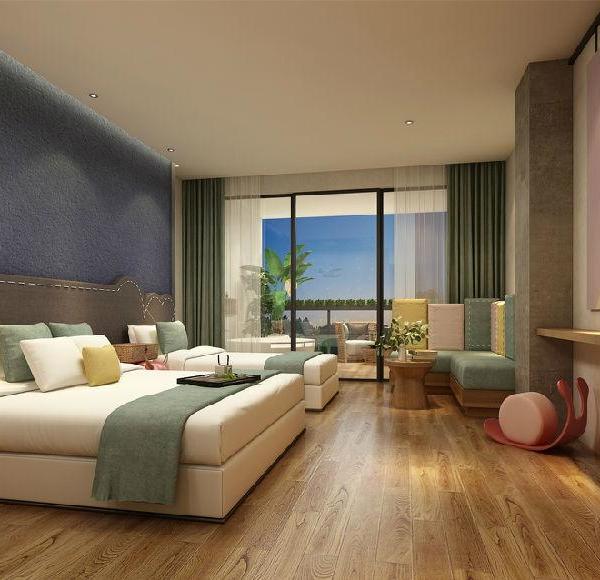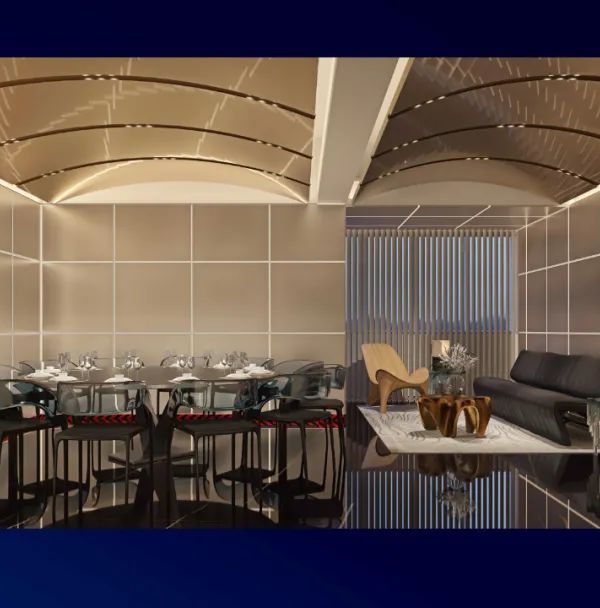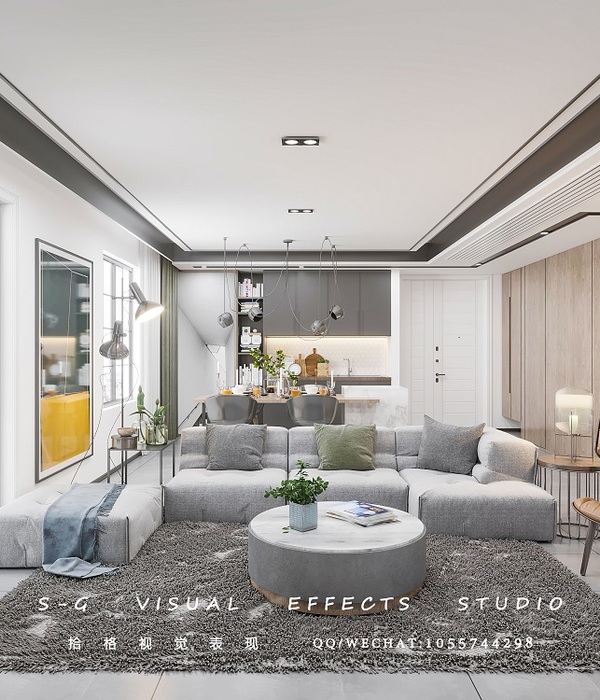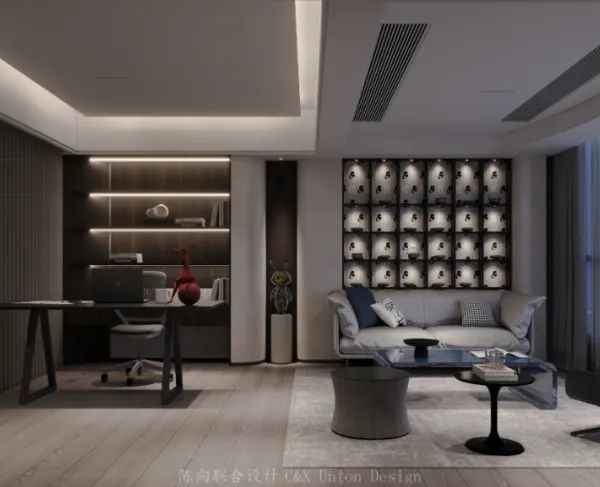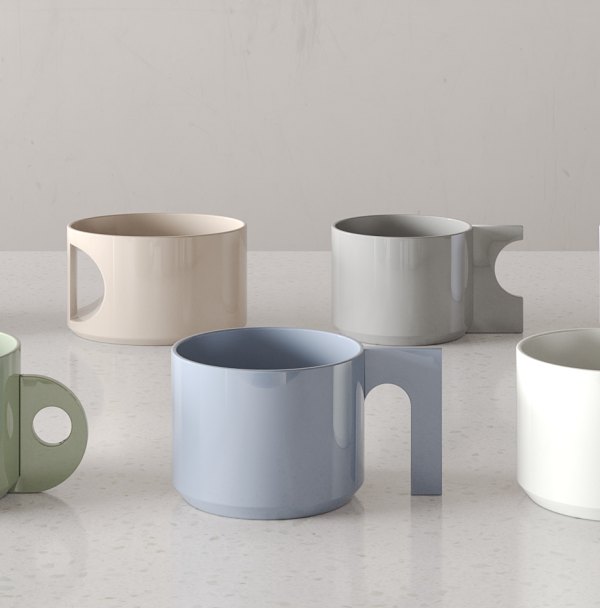地点 WHERE 本项目坐落于意大利古罗马时期就规划而成的古城 —— 弗利(Forlì),建筑位于弗利郊区的某工业区内。场地靠近高速公路出口,距离老城区中心只有几公里。虽然具有战略性的区位优势,但周边环境中建筑语言却极度匮乏,仅有单调的预制仓库。
The building is situated on the outskirts of the city of Forlì, within an industrial zone that the town planning authorities have located on the edge of the ancient Roman centuriation. The site is located in close proximity to the motorway exit and just a few kilometres from the old town centre, a highly strategic point but one which is devoid of architectural language: the landscape is dominated only by a monotonous parade of prefabricated warehouses.
▼项目概览,overall of the project© MD
计划
PLAN
因此,可以说本项目周围的环境虽没有亮点,但同时也没有限制。除了满足业主公司提出的刚性和强制性功能要求外,设计任务书可被归纳为以下三点: - 建筑必须确保办公空间配置的最大灵活性,同时避免开放式模式,并保证单人或双人的专属工作空间; - 总部供分为六个部门,每个部门都必须位于同一层; - 项目中必须包括一个 200 个座位的会议厅和自助餐厅空间,并在需要时,转换为办公空间。
Therefore, the project was to be inserted into surroundings that offered neither ideas nor constraints, other than those related to the rigid and mandatory functional brief presented by the cooperative, which can be summarised in three points: - The building had to ensure maximum flexibility in the configuration of office spaces while avoiding an open-plan formula and guaranteeing exclusive work spaces for 1 or 2 people; - Each of the six departments into which the company is divided had to be housed on a single level; - The project had to include a 200-seat assembly hall and cafeteria space that could be converted into office space if required.
▼地面层视角,perspective view on the ground level© PS
因此,建筑师有意识地避免在最初的设计中过多地关注结构形式本身,而是通过调整建筑的线条来适应功能和后勤的需求。可以说,建筑最终呈现出来的外观是一个创造性过程的结果,它吸收了业主公司崇尚的理性和实用主义,使总部本身成为公司科学严谨的代名词。
From the outset, therefore, a conscious decision was made to avoid focusing too heavily on structural form per se in the initial designs, but rather to let the building reveal itself by adapting its lines to the functional and logistical needs imposed. The form that can be appreciated today is the result of a creative process that paradoxically absorbs the rationality and pragmatism of the cooperative, making the headquarters itself the primary representation of the company’s scientific rigour.
▼半鸟瞰,half aerial© MD
建筑外观
EXTERNAL PROJECT
Sidera 大楼水平向长度为 100 米,从 3 米高的地基以上开始计算,建筑总高度为 33 米。建筑外立面采用了三种不同的材料,分别为总长度达 6 千米的垂直铝制翅片、黑色混凝土,以及约 5000 平方米的玻璃。外立面中的天然铝材起着主导作用,这种材料能够优雅地反射自然光,在一天中的不同时间和天气条件下呈现出不同的色彩和色调。
▼草图,sketches© tissellistudioarchitetti
The Sidera building extends horizontally for a length of 100 metres and has a height of 33 metres, starting from a soil plinth that is approximately 3 metres high. The external surface features only three materials: aluminium (six kilometres of vertical fins), black pigmented concrete, and glass (about 5000 square metres of glazing on the façade). The natural aluminium used for the cladding sheets plays the leading role as it elegantly reflects the natural light, taking on different nuances of tone and colour at different times of the day and depending on the weather conditions.
▼半鸟瞰,half aerial view© MD
▼立面细部,details of the facade© MD
铝制翅片与遮阳板相互结合,创造出轻快的立面节奏。当人们在 Sidera 大楼周围移动时,就会体验到一种令人愉快的视觉错觉。在不同的视角下,建筑时而变得坚固时而变得透明,隐匿在周围环境中。
This, combined with the rapid rhythm created by the placement of the sunshade fins, creates a pleasant optical illusion as one moves around the Sidera building, whereby the building appears as either an opaque or transparent block, depending on the position from which it is viewed.
▼建筑入口,entrance of the building© PS
▼玻璃立面,glazing facade© MD
▼细部,details© MD
▼底层停车场,parking lot© PS
建筑外壳的设计概念不仅在于外立面,还涵盖了作为第五立面的屋顶。随着谷歌地球等当代导航工具的兴起,人们现在都开始习惯于从上面看和感知空间。这种意识的转化为本建筑带来了独特的视角。为了实现独特的第五立面,建筑师选择了坡屋顶的设计,这种设计在这样的工业环境中是前所未有的。六个倾斜的屋面分散在整个空间中,利用三扇大天窗作为连接点,寻求与附近亚平宁山脉的天际线建立对话。
The concept of the envelope of the building does not refer only to the exterior façades, but also includes the roof, which was immediately interpreted as a kind of fifth elevation. Since we are aware of the fact that with the rise of contemporary navigation tools, such as Google Earth, we are now all accustomed to looking at and perceiving spaces from above. This awareness translates into the need to also include defining architectural features for this viewpoint. The vernacular motif of the pitched roof was selected for this purpose, which, in itself, is unprecedented in such an industrial context. Six sloping pitches are scattered across the space exploiting the three large skylights as connection points, in the quest to create a dialogue with the skyline of the nearby Apennines.
▼顶视图,top view© MD
▼屋顶鸟瞰,top view of the roof© MD
▼屋顶花园,roof garden© MD
▼屋顶花园近景,roof garden© PS
室内设计和神经建筑学
INTERIOR DESIGN AND NEURO-ARCHITECTURE. 室内空间的研究和设计并非是独立于建筑设计的平行部分,而是整个项目发展的必要环节。设计初衷从一开始就清晰明了,即摒弃将外观视为建筑独特性的体现,而是将其塑造为一种更为有机且复杂的外壳,为人们注入源源不断的启发和灵感。设计师笃信,相较于单调寻常的中规中矩空间,该建筑所能引发的好奇心和复杂性,将更好地滋养在其中工作的人们,促使他们更具创造性。
▼草图,sketchs© tissellistudioarchitetti
The study and design of the interior space was approached as an essential component in and of itself, and thus, not viewed as a parallel project but something integral and necessary for the development of the building as a whole. Indeed, the intention was clear from the very first steps, not to entrust the representativeness of the project to the exterior envelope of the building alone, but to ensure it was the skin of a more complex organism, expressed in a continuous progression of stimuli. We were fortified by the conviction that the intelligence and creativity of those who work and produce are nourished in their endeavours by the curiosity and complexity of the building rather than the banality of a sterile and shapeless space.
▼接待区,reception© MD /PS
▼天窗,skylight© PS
▼走廊,hallway© PS
▼卫生间,toilets© PS
神经建筑学的原则指导了大部分的设计选择,旨在探寻最理想的工作空间模式。因此,外部因素,如光、空气、声音和视觉,以集成或控制设备元素的方式结合在空间中,而非仅仅作为必要的建筑结构。例如,大楼外立面上的玻璃控制着自然光的流入,为每个工作空间营造出明亮舒适的氛围;灯具的开关遵循 24 小时的昼夜节能规律;另外,通风控制技术和完全封闭的窗扇,在这个污染最严重的地区之一,保证了室内空间的清洁与健康。所有这些元素,加上对隔音的严格控制,保证了良好的工作条件,从而保障员工高水平的心理健康,且自然而然地转化为员工更高的工作质量。
▼分析图,analysis diagram© tissellistudioarchitetti
The precepts of neuro-architecture have guided most of the design choices, which focused on finding the ideal working space. Thus, external factors, such as light, air, sounds, and visuals, enter the building in the form of calibrated and controlled architectural components and not merely as necessary occurrences. The glass skin covering the Sidera building controls the inflow of natural light that floods every workspace; the light fixtures follow the 24-hour circadian rhythm; the technology employed for ventilation control and the total absence of operable windows ensure the indoor air is clean and healthy despite being in one of the most polluted areas in Europe. From every interior space and from any level, it is possible to look out on the view of greenery outside. All these factors, combined with the obsessive control of sound insulation, guarantee working conditions that foster high levels of psychological well-being, which inevitably translates into a higher quality of work from employees.
▼走廊,hallway© MD /PS
除了材料的自然色彩外,没有添加任何颜色,以至于建筑的照片看起来有些不饱和。但正是这种朴素的色彩,进一步突显了建筑的形式,强调了该建筑作为公司总部的地位。木材、铝和混凝土等材料以其最自然的状态呈现,这种精神也体现在 Corian 为本项目特别定制的办公家具中。从这个意义上说,建筑的严肃反映了公司的认真和务实。
No colour has been added beyond the natural pigmentation of the materials, so much so that the photograph of the building appears desaturated: an inverted form of highlighting that emphasises the building’s rank as the company’s headquarters. Wood, aluminium and concrete proudly express their natural state, and this ethos also applies to the many items of bespoke furniture made from Corian. The sobriety of the building in this sense reflects the seriousness and pragmatism of the company.
▼会议室,meeting room© PS
▼办公区,office area© PS
▼明亮的环境氛围,bright interior environment© PS
在碎片化的空间形态与对角线之间,大型内部楼梯作为整个空间的突出元素,是一个可以全览到 Sidera 大楼内部高度的空间。它的浑厚与蜿蜒的线条形成对比,凝聚出具有“破坏性”的向心力,将游客吸引到楼梯间。楼梯栏杆形成的缎带蜿蜒向上,如同活的有机体,像树枝一样被穿透大天窗的阳光所吸引。
Between shard-like shapes and diagonal slashes, the large internal staircases act as an element of disruption for the entire layout, starting from the fact that it is the only space from which the full internal height of the Sidera building can be enjoyed in all its glory. The hypertrophic and sinuous lines play with contrast, drawing the visitor towards itself like a disruptive centripetal force. The ribbon created by the parapet of the staircase worms and winds its way upward, like a living organism whose branches are attracted by the sunlight that penetrates through the large skylight.
▼楼梯天井,patio of the staircase© MD
▼俯视楼梯,overlooking the staircase MD
▼细部,details© MD
宽大的楼梯平台上设有舒适的座位,所有交通空间中都是如此。这些座位区创造了一系列小型广场和会议区域,邀请人们停下来相互交流,从而在办公室内培养了一种社区意识。因此,员工之间的社交时刻受到鼓励,让人们更加相信分享想法和建立积极关系是确保整体福祉的基本因素,这是生产力的基石。人本身就成了项目的重要组成部分,是启动一个充满齿轮的机器的钥匙;当机器运行时,就会产生有趣刺激的故事,充满惊喜,引发人们源源不断的灵感。
Large landings are home to comfortable seating, which is present here as in all the circulation paths. Creating small squares/meeting points that invite people to stop and interact with each other, thereby fostering a sense of community within the office. Social moments among employees are thus encouraged, strengthened by the belief that the sharing of ideas and the creation of positive relationships are fundamental factors in ensuring general well-being, which is the cornerstone of productivity. People themselves thus become a component part of the project, the key required to activate a machine that is full of cogs and gears; and when the machine is allowed to run, it generates a stimulating narrative, full of surprises, constantly searching for reactions.
▼楼梯平台与交通空间,landings and circulation area© MD
▼细部,details© MD
▼座位区,seating area© MD
Sidera 大楼是一个活生生的、富有创造性的有机体,它否认了正交性的严格逻辑,避免了所有静态约束或对不朽和平庸对称的义务。入口、交通空间、会议厅和顶楼都被规划在由墙壁、天花板以及倾斜的折面组成的不规则空间中,并在空间的交织与压缩中相互作用。
The Sidera building is a living, creative organism that denies the rigid logic of orthogonality and avoids all static constraints or obligations to monumental and banal symmetry. The entrance, the circulation spaces, the assembly hall, and the top floor are all arranged in an interplay of alternating spatial compressions between the walls and ceilings and the sloping and faceted surfaces.
▼报告厅,lecture hall© MD
▼报告厅细部,details of the lecture hall© MD
▼细部,details© MD
在缺乏特点与建筑价值的环境中,Sidera 大楼为平庸的环境引入了新鲜血液,它就像是一个礼物,让这个缺乏质量的区域带来了更好的可能性,不仅为公司的员工也为使用它的每个人都带来了益处与福祉。此外,总部周围亲种植的 300 棵树和 22000 株植物,则进一步优化了建筑周围的环境。
In a context that is devoid of identity and architectural value, the Sidera building has been conceived to be a new element to add to its surroundings, like a sort of gift, a form of reparation to an area lacking in quality but one which can evidently become a better area, for the benefit of anyone who comes to make use of it (in particular, the employees of the cooperative). Even the decision to surround the headquarters with 300 trees and 22,000 plants is a response to the desire to neutralize the context in which it is built.
▼夜景,night views© MD /PS
该总部的设计既不崇尚形式主义,也不崇尚个人主义。但是,在它的核心,有一种强烈的现实感,一种强烈回应人们需求的意图,并将这种需求转化为了建筑。人类不可避免地要经历变革,但人际关系却始终在其间占据着不可忽视的中心地位。时刻谨记人类和个体在当今社会的意义,就不会让我们越来越远离彼此,越来越远离我们周围的环境。
In the design of the headquarters, there is no formalism, nor individualism but, at its core, there is a strong sense of reality, a strong intention to interpret needs, to understand and translate into the building. The transformations that mankind inevitably goes through, without ever losing sight of the centrality of relationships and of what being a human and an individual means in the present day, which keeps us increasingly distant from each other and from the environment that surrounds us.
▼总平面图,master plan© tissellistudioarchitetti
▼地下层平面图,b1 plan © tissellistudioarchitetti
▼一层平面图,1f plan© tissellistudioarchitetti
▼二层平面图,2f plan © tissellistudioarchitetti
▼三层平面图 3f plan © tissellistudioarchitetti
▼四层平面图,4f plan© tissellistudioarchitetti ▼五层平面图,5f plan© tissellistudioarchitetti ▼六层平面图,6f plan© tissellistudioarchitetti ▼七层平面图,7f plan© tissellistudioarchitetti
▼屋顶平面图,roof plan© tissellistudioarchitetti
▼立面图,elevations© tissellistudioarchitetti
▼分析图,analysis diagram© tissellistudioarchitetti
▼剖面图,sections© tissellistudioarchitetti
▼细部详图,detailed drawing© tissellistudioarchitetti
Architectural planning: tissellistudioarchitetti Structural planning: aei progetti / gabriele casadio Mechanical systems: idrotermica coop Electrical systems: SBE S.r.l. Building automation: Casadei & Pellizzaro S.r.l. Landscape planning: Paisa’ Anti-intrusion system: Elettronica Cortesi S.r.l. Acoustics: Andrea Farnetani
{{item.text_origin}}

